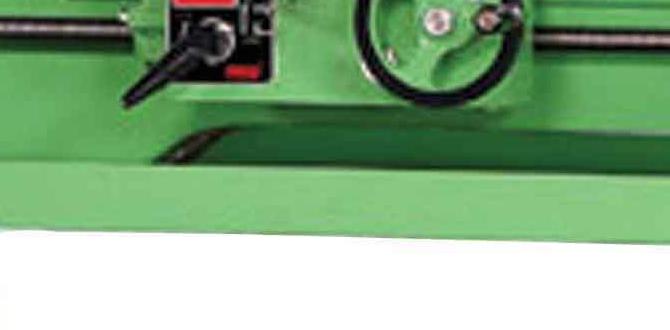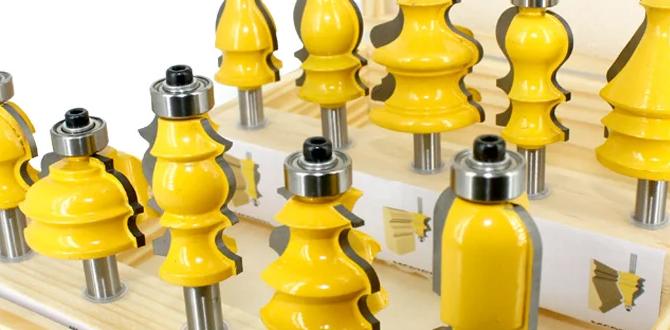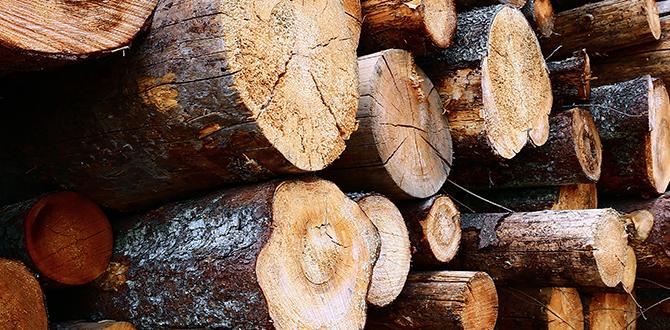Precision lathe machines for manufacturing create highly accurate parts with speed and consistency. They are essential for producing everything from tiny, intricate components for electronics to large, robust parts for aerospace. Investing in the right precision lathe can significantly boost your workshop’s capabilities, reduce errors, and improve your overall output. This guide explains how they work and why they are so valuable.
Hey there, fellow makers and aspiring machinists! Daniel Bates here from Lathe Hub. Ever looked at a perfectly round bolt or a smoothly finished piece of metal and wondered how it got that way? It’s a common question, especially when you’re just starting out. Precision lathe machines are the unsung heroes of manufacturing, turning raw materials into incredibly accurate components that power our world. Sometimes, understanding these complex machines can feel a bit daunting, but that’s where I come in. Think of me as your guide, breaking down exactly what makes these lathes so special. We’ll discover how they achieve pinpoint accuracy and why they’re a game-changer for any sort of workshop, big or small. Ready to unlock the secrets of precision machining? Let’s get started!
What is a Precision Lathe Machine?
A precision lathe machine is a highly accurate metalworking machine tool used to shape pieces of material by rotating them against a cutting tool. Unlike standard lathes, precision lathes are engineered with tighter tolerances, advanced control systems, and superior build quality. This allows them to create components with extremely fine finishes and dimensional accuracy, often measured in microns. They are the backbone of industries where even the slightest error can lead to failure, such as aerospace, medical device manufacturing, and high-tech electronics.
The Core Principle: Material Removal with Accuracy
At its heart, any lathe works by spinning a workpiece securely held in a chuck or collet. A cutting tool, mounted on a tool post, is then brought into contact with the spinning material. As the material turns, the cutting tool shaves away excess material, gradually forming the workpiece to the desired shape and size. What sets a precision lathe apart is the remarkable stability, rigidity, and control offered by its design and components.
Key Components of a Precision Lathe
Understanding the parts helps us appreciate the precision. Here are the main components you’ll find:
- Bed: The foundation of the lathe, offering stability and vibration damping. A precision lathe’s bed is often made of high-quality cast iron and precisely ground.
- Headstock: Houses the spindle that rotates the workpiece. Precision spindles are balanced and mounted in ultra-accurate bearings to minimize runout.
- Tailstock: Provides support for long workpieces or can hold tools like drills.
- Carriage: Supports the cutting tool and moves along the lathe bed. This includes the cross-slide and compound rest, which allow for precise feeding of the tool.
- Saddle: The part of the carriage that moves along the bed.
- Tool Post: Holds the cutting tool securely.
- Leadscrew and Feed Rod: Control the movement of the carriage for operations like threading and turning.
- Control System: In modern precision lathes, this is often a sophisticated CNC (Computer Numerical Control) system that dictates movements with extreme accuracy.
These components work in harmony. For manufacturing, especially for creating identical parts repeatedly, the precision in each of these elements is what makes the difference between a good part and a perfect one.
Why Choose Precision Lathes for Manufacturing?
When your production needs require parts that fit together flawlessly, last longer, and perform under demanding conditions, standard machinery just won’t cut it. Precision lathes are designed to meet these challenges head-on. They offer a combination of benefits that are crucial for modern manufacturing.
Unmatched Accuracy and Tolerance Control
This is the absolute top reason. Precision lathes are built to extremely tight specifications. This means they can produce parts with very small deviations from the intended dimensions, often within a few ten-thousandths of an inch (or even less!). This is vital for:
- Interchangeable Parts: Manufacturing components that need to fit perfectly with other parts without manual adjustment.
- Functionality: Ensuring that components like bearings, gears, or engine parts operate smoothly and efficiently.
- Reduced Waste: Minimizing the number of parts that fail quality control due to dimensional inaccuracies.
Consistency and Repeatability
For mass production, ensuring every part is the same is as important as the initial accuracy. Precision lathes, especially CNC models, can perform the same operation on hundreds or thousands of workpieces with virtually no variation. This consistency is fundamental to reliable manufacturing processes. Imagine producing thousands of identical medical implants; each one must be perfect, and a precision lathe makes this possible.
Superior Surface Finish
Beyond just shape and size, the smoothness of a part’s surface is often critical for its function and lifespan. Precision lathes can achieve exceptionally smooth finishes, reducing friction, wear, and the need for secondary finishing operations. This means less polishing, grinding, or other labor-intensive post-processing steps, saving time and money.
Ability to Work with Difficult Materials
Many advanced materials used in modern manufacturing, such as specialized alloys, high-performance plastics, and composites, can be challenging to machine. Precision lathes, with their rigid construction and controlled cutting forces, are better equipped to handle these materials without deforming them or causing excessive tool wear.
Reduced Scrap and Rework
When you’re working with expensive materials or complex designs, the cost of a mistake can be significant. The high accuracy and repeatability of precision lathes drastically reduce the chance of errors, leading to less scrap material and fewer parts needing rework. This directly impacts your bottom line and overall productivity.
Enhanced Productivity
While initially an investment, precision lathes can boost productivity in several ways:
- Faster cycle times for complex operations.
- Reduced setup times for repeat jobs.
- Less time spent on quality inspection and rework.
- Automated operation through CNC, allowing for “lights-out” manufacturing.
Types of Precision Lathe Machines
Not all precision lathes are created equal. The specific type you choose will depend on the size of your parts, the complexity of the operations, and your budget. Here’s a look at some common types:
1. CNC (Computer Numerical Control) Precision Lathes
These are the workhorses of modern precision manufacturing. A CNC lathe uses a computer to control all machine functions, including the movement of the cutting tools, spindle speed, and coolant flow. Programmed with G-code, they can execute incredibly complex machining sequences automatically and with exceptional accuracy. CNC lathes are ideal for high-volume production, intricate geometries, and applications where repeatability is paramount.
Advantages:
- Extreme accuracy and repeatability.
- Ability to perform complex shapes and operations.
- Reduced human error.
- Faster production cycles for complex parts.
- Ideal for unattended operation.
Considerations:
- Higher initial cost.
- Requires skilled operators or programmers.
- Programming can be complex for intricate tasks.
2. Toolroom Lathes
Toolroom lathes are designed for high-precision, low-volume work, often used in tool and die shops, research and development, and for prototyping. They are built with a focus on fine adjustments and exceptional accuracy to produce master tools, gauges, and prototype components. While they may not have the automation of a CNC, they offer immense control to a skilled machinist.
Advantages:
- Exceptional manual control for intricate details.
- Built for high accuracy and fine finishes.
- Versatile for a wide range of single-part jobs.
- Often more affordable than comparable CNC machines.
Considerations:
- Requires highly skilled manual operators.
- Slower for high-volume production.
- Less repeatable than CNC machines.
3. Swiss-Type (Sliding Head) Lathes
Swiss-type lathes are specialized machines designed for producing very small, slender parts with high precision. Unlike conventional lathes where the workpiece extends from the headstock, in a Swiss lathe, the workpiece is fed through a guide bushing. The cutting tools then move across the stationary workpiece. This setup minimizes vibration and deflection, making it perfect for producing tiny, intricate components like those used in watches, medical devices, and electronics.
Advantages:
- Excellent for small, slender, and complex parts.
- Superior accuracy and surface finish for tiny components.
- Reduced tool pressure and vibration.
- Often equipped with multiple axes and live tooling for complex machining in one setup.
Considerations:
- Specialized for small parts; not suitable for large workpieces.
- Can have a steeper learning curve.
- Higher cost than standard lathes.
4. Engine Lathes (High-Precision Models)
While the term “engine lathe” often brings to mind older, less precise machines, there are modern engine lathes built to much higher standards of accuracy. These are versatile machines that can perform a wide range of turning, facing, and threading operations. When selecting a high-precision engine lathe for manufacturing, look for features like a rigid cast-iron bed, hardened ways, precision bearings in the headstock, and a finely graduated carriage for accurate manual control.
Advantages:
- Versatile for a broad range of tasks.
- Often more accessible for smaller workshops or startups.
- Good for prototyping and small to moderate production runs.
Considerations:
- Accuracy relies heavily on operator skill.
- Less repeatable than CNC.
- May require more frequent calibration than higher-end machines.
Choosing the Right Precision Lathe for Your Manufacturing Needs
Selecting the correct precision lathe machine for manufacturing is a critical decision that impacts quality, efficiency, and profitability. It’s not just about buying the most expensive machine; it’s about finding the best fit for your specific application. Here’s a breakdown of factors to consider:
1. Part Size and Complexity
This is often the first determining factor.
- Small, intricate parts: Consider Swiss-type lathes or smaller CNC lathes.
- Medium-sized, standard parts: A versatile CNC turning center or a high-precision engine lathe might be suitable.
- Large, heavy parts: You’ll need a larger-capacity heavy-duty precision lathe.
2. Production Volume
Are you making one prototype, a hundred units, or thousands?
- High Volume: CNC lathes are almost always the best choice for consistent, high-volume production.
- Medium Volume: CNC is still excellent, but a well-equipped engine lathe could also work if labor is available and costs are a concern.
- Low Volume/Prototyping: Toolroom lathes or versatile engine lathes excel here, allowing for close operator control.
3. Required Accuracy and Surface Finish
What are your tolerance requirements?
- Critical Tolerances (Microns): CNC lathes, especially those designed for high-speed machining, and Swiss-type lathes are necessary.
- Standard Machining Tolerances: Well-maintained engine or toolroom lathes can often achieve this.
- Exceptional Surface Finish: Features like precise spindle bearings, rigid construction, and advanced tooling support are key.
4. Budget
Precision machinery represents a significant investment.
- Entry-Level: High-quality engine lathes or small benchtop CNC lathes offer a starting point.
- Mid-Range: Full-sized CNC lathes or advanced toolroom lathes.
- High-End: Multi-axis, high-speed CNC turning centers, and specialized Swiss-type machines.
5. Operator Skill and Training
Do you have machinists experienced with manual controls, or do you need to program CNC machines?
- Manual Machinists: Engine and toolroom lathes are a good fit.
- CNC Programmers/Operators: CNC lathes are the obvious choice.
Remember, investing in training for your team is often as important as investing in the machine itself.
6. Machine Rigidity and Spindle Quality
A rigid machine and a high-quality spindle are paramount for precision work. Look for:
- Cast Iron Construction: Provides excellent damping for vibrations.
- Hardened and Ground Ways: Ensure smooth, accurate movement of the carriage.
- Precision Spindle Bearings: Minimize runout and vibration for tight tolerances and good finishes.
Key Features for Enhanced Precision
When evaluating precision lathe machines for manufacturing, certain features distinguish those capable of true precision work from general-purpose machines. These advancements are what allow for the micron-level accuracy demanded by modern industries.
High-Rigidity Construction
A foundational aspect. The heavier and more rigid the machine, the better it can resist vibrations and cutting forces. This prevents tool chatter and ensures consistency. Materials like high-grade cast iron, precisely machined steel, and a hefty base are indicators of good rigidity.
Precision Spindle and Bearings
The spindle is the heart of the lathe. For precision work, it needs to be perfectly balanced and run on extremely accurate bearings (like angular contact ball bearings). This minimizes any wobble or runout, which is crucial for maintaining tight tolerances on the workpiece.
Ground and Hardened Ways
The ways are the guides on the lathe bed that the carriage and cross-slide travel along. For precision, these need to be hardened (to resist wear) and then ground to a very smooth and flat finish. This ensures repeatable and accurate movements of the cutting tool relative to the workpiece.
Precision Lead Screws and Ball Screws
For automated or very fine manual movements, the lead screws (for threading) and feed screws (for carriage movement) are critical. In CNC lathes, high-precision ball screws are used, which offer excellent accuracy, low friction, and long life.
Advanced Control Systems (CNC)
Modern CNC systems are incredibly sophisticated. They allow for:
- High-Resolution Feedback: Positional accuracy to 0.0001 inches or better.
- Programmable Speeds and Feeds: Optimized for different materials and operations.
- Complex Path Control: Machining curves, tapers, and intricate geometries with ease.
- Error Compensation: Some systems can even compensate for thermal expansion or minor wear.
This integration of hardware and software is what enables the highest levels of precision.
Coolant Systems and Chip Management
Effective coolant delivery is essential for controlling workpiece temperature, extending tool life, and flushing away chips. Precision machines often feature high-pressure coolant systems that can be directed precisely where needed. Good chip management systems prevent jamming and damage to the machine or workpiece.
Workholding Options
The way the workpiece is held is as crucial as the machine itself. Precision lathes offer various advanced workholding solutions:
- High-Precision Collets: For holding bar stock with minimal runout.
- High-Performance Chucks: Power or manual chucks designed for accuracy and grip force.
- Custom Fixtures: For specialized or irregularly shaped parts.
Safety First! Operating a Precision Lathe
As with any powerful machinery, safety is paramount when operating a precision lathe. These machines are incredibly capable, but also demand respect and caution. Always prioritize safety, and never work if you feel tired or distracted. For a comprehensive guide to machine shop safety, OSHA provides excellent resources, such as their Machinery and Machine Guarding Safety guidelines.
Essential Safety Practices:
- Wear Appropriate PPE: Always wear safety glasses with side shields. Consider hearing protection and safety shoes. Never wear gloves when operating a lathe, as they can get caught and pull you into the machine.
- Secure Workpiece and Tool: Ensure the workpiece is securely held in the chuck or collet and that the cutting tool is firmly seated in the tool post. Loose workpieces are a major hazard.
- Proper Clothing: Avoid loose clothing, jewelry, or long hair that can get caught in rotating parts.
- Clear the Machine Area: Keep the workspace around the lathe clean and free of clutter, tools, and debris.
- Never Leave a Running Lathe Unattended: Especially important for manual machines, but also good practice for automated CNC cycles.
- Use Correct Speeds and Feeds: Consult material charts or machine manuals to ensure you are using appropriate cutting parameters.
- Always Stand Clear of Rotating Parts: When the machine is on, be aware of the danger zone around the spinning workpiece.
- Eng





